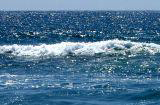Red Tides
What Are Red Tides?
Nearly every summer red tides, or harmful algal blooms (HABs), appear along some of Florida’s coasts, turning the water red or brown.
Red tides—which can last anywhere from a few weeks to more than year—are created when tiny plants or algae overgrow, discoloring the water and, at times, producing harmful effects or toxins.
While many refer to this algae overgrowth as a red tide, researchers prefer the term harmful algal bloom, because red tides can have nothing to do with actual tides and can be harmless. In fact, many algal blooms can benefit marine life because the microscopic plants serve as food.
HAB Damage
Even though a small amount of algae blooms actually produce toxins, HABs can:
- Block light from plants
- Deplete oxygen in the water
- Suffocate fish
- Kill fish, birds, and marine animals due to toxins
- Negatively affect coastal businesses and tourism
- Poison people who eat tainted seafood
- Cause respiratory irritation among people and pets
- Damage coral reefs
- Reduce water quality
Reducing the Risks
While researchers have been unable to control algae blooms, they can determine where they will travel. If HABs have been confirmed in your area, then protect yourself against the potentially harmful toxins with the following tips:
- Do not swim or get near water.
- Avoid collecting marine life, such as crabs, mollusks, and fish.
- Do not allow your pets to swim or eat fish.
- If you entered the water, then rinse your body as soon as possible.
- Do not eat the internal organs of fish or consume recreationally harvested shellfish.
- Note that cooking or freezing fish will not kill the red tide toxin.
- Some people and pets undergo respiratory discomfort from blooms—if so, then move away from the shore or stay indoors.
If you would like to know the red tide status in your area, then visit the Current Map of Red Tide Counts from the Florida Fish and Wildlife Conservation Commission.
Excerpted and adapted from:
J. R. Rey, “Red Tides” (ENY851), UF/IFAS Entomology & Nematology Department (rev. 02/2014).
“Ocean Facts: Red Tide,” National Oceanic and Atmospheric Administration (Accessed 07/2014).
“Red Tide FAQ,” Florida Fish and Wildlife Conservation Commission (Accessed 07/2014).

Related Sites & Articles
- Hot Topics
- Coastal Wetlands
- Green Marine Practices
- Rip Currents
- UF/IFAS Publications
- Coastal Waters Series
- Harmful Algal Blooms, or Red Tides Series
- Water Quality Series
- UF/IFAS Sites
- All About Water Quality
- UF Water Institute
- Other Sites & Publications
- About Florida Red Tides—Florida FWC
- Red Tide Current Status—Florida FWC
For-Sale Products
- Living at the Lake
- Florida's Aquatic Plant Story
- Freshwater Plants in the Southeastern United States
- What Makes a Quality Lake?

